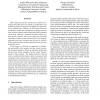Free Online Productivity Tools
i2Speak
i2Symbol
i2OCR
iTex2Img
iWeb2Print
iWeb2Shot
i2Type
iPdf2Split
iPdf2Merge
i2Bopomofo
i2Arabic
i2Style
i2Image
i2PDF
iLatex2Rtf
Sci2ools
ISORC
2003
IEEE
2003
IEEE
Probabilistic Simulation-Based Analysis of Complex Real-Time Systems
Many industrial real-time systems have evolved over a long period of time and were initially so simple that it was possible to predict consequences of adding new functionality by common sense. However, as the system evolves the possibility to predict the consequences of changes becomes more and more difficult unless models and analysis method can be used. Moreover, traditional real-time models, e.g., fixed priority analysis, may be too simple for accurately capturing a complex system’s characteristics. For instance, assuming worst-case execution time may not be realistic. Hence, analyses based on these models may give an overly pessimistic result. In this paper we describe our approach to introducing analyzability into complex real-time control systems. The proposed method is based on analytical models and discrete-event based simulation of the system behavior based on these models. The models describe execution times as statistical distributions which are measured and calculated ...
Difficult Unless Models | Execution Times | ISORC 2003 | Software Engineering | Traditional Real-time Models |
| Added | 04 Jul 2010 |
| Updated | 04 Jul 2010 |
| Type | Conference |
| Year | 2003 |
| Where | ISORC |
| Authors | Anders Wall, Johan Andersson, Christer Norström |
Comments (0)

